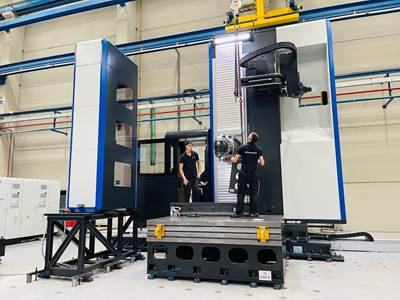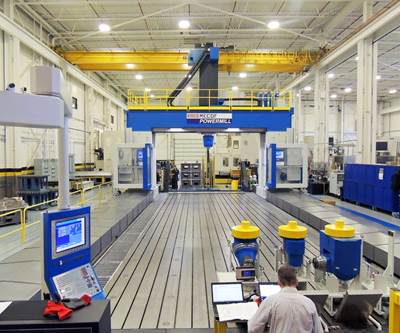Share




Many manufacturing processes require tooling, though most manufacturers outsource production of this tooling. In-house tooling production requires an investment in machine tools and people to run them, but as a manufacturer of rubber belting products has discovered, this investment can save time and money not only for itself, but for its sister facilities as well.

The Continental facility in Wahpeton, North Dakota, added more toolmaking capacity ten years ago, starting with this Haas GR-712 gantry router. This machine is much larger than the toolroom mills the facility was using previously, enabling it to produce larger plate tooling or several smaller tools, which are then used in the production of rubber belting products. All photos provided by WCCO Belting.
Belting It Out
When automotive parts supplier Continental acquired WCCO Belting in Wahpeton, North Dakota, in 2022, many of Continental’s other facilities were surprised by its machining capabilities. WCCO makes rubber belting products for the agricultural, industrial, playground equipment, recycling and mining industries, but its equipment includes two CNC gantry routers (a Haas GR-712 and GR-510), a Haas TM2 toolroom mill, two manual knee mills (from Acer and Emco) and an Omax waterjet cutting machine.
WCCO primarily uses this fleet of metalworking equipment to produce tooling for the rubber vulcanizing presses that produce rubber belts. This tooling often takes the form of large aluminum plates with features such as grooves, notches and chamfers machined into the surface. The facility has also found these machine tools useful for making repair parts for various machines. While the geometry of the parts the Wahpeton facility produces may vary, they all have one thing in common: “Nothing we machine is sold to an end customer,” notes plant manager Rod Koch.

The Wahpeton facility also added this Haas GR-510 gantry router to further expand its toolmaking capabilities. With these machines, the manufacturer can now produce tools it was previously sending out, saving time and money.
From Outsourced to In-House
The Wahpeton facility began bringing machining in-house roughly ten years ago, shortly after Koch took over as head of operations. WCCO Belting, as it was called then, had one toolmaker on staff, along with a toolroom mill. But the company was having trouble sourcing tooling for its rubber belting products. “Tooling lead times were exorbitant,” he explains. “The timeline wasn't good, and they didn't understand our exact needs.”
He realized that machining could add a lot of value to the business. “I penciled it out and went to our president at the time,” Koch says. “He looked at it and said, ‘Why didn't we do this years ago?’”
WCCO started by adding a machine with a larger work envelope so it could begin producing larger plate tooling in-house. These pieces of tooling were particularly difficult to outsource. “You're at the mercy of shipping damage and potential markup costs,” Koch says. “Maybe they don't understand the exact requirements, maybe the surface finish isn't the way we need it.”
So the company bought a used Haas GR-712 gantry router from Canada and rebuilt it, including redoing the ways and linear rails and resurfacing the bed. According to Koch, “The payback period was months.” Three and a half months to be precise, and the machine is still running nearly 10 years later. “The 712 has yet to shut off,” he adds. “It runs a lot. We're always machining something.” The 7-foot by 12-foot table enables the facility to produce larger plate tooling, which can reach up to 8 feet in length, or multiple smaller tools or parts. It also added a Haas GR-510 several years ago to further expand its machining capacity, as well as an Omax waterjet cutter, which Koch says is handy for cutting out complex shapes in a variety of materials.

In addition to the larger gantry routers, the facility has a Haas TM2 toolroom mill, two manual knee mills and an Omax waterjet cutting machine. Other Continental shops have even benefited from Wahpeton’s added machining capacity.
Lending a Helping Hand
Bringing toolmaking in-house has not only reduced costs and lead times for the Wahpeton facility, the process of making the tooling is now much smoother. The team of full-time, in-house toolmakers, which has expanded from one to three, has specialized knowledge that outside vendors don’t have. “They’re full-time employees here and they know exactly what works and what doesn't for our belting requirements for production,” Koch notes. Communication is also much easier with an in-house team than it is with outside vendors. “If the toolmakers have a question, in 30 seconds, you can answer it and they're off and running,” he adds.
The Wahpeton facility has also been able to use its extra machining capacity and specialized knowledge to help out at least three other Continental facilities. “We understand their requirements as well, because they're making similar products,” Koch explains. He was recently talking to his counterpart at a sister facility in Halstead, Kansas, which had a damaged piece of tooling and had been waiting two weeks for a quote to repair it. Koch told his counterpart to send him a print, which he shared with the Wahpeton toolmakers, who were able to make a new part. “We even had a chunk of aluminum barstock on the rack,” Koch notes. The process took five days from first contact to the machine being back in production.
The manufacturer is also considering expanding its machining capacity even further by adding a five-axis machine. Koch says the team is able to make everything it needs to make, though sometimes this requires sine plates, special fixturing and indexing parts multiple times. “A five-axis machine would really truncate machining time, expand our capabilities and let us get away with more challenging designs,” he says.
The Value of In-House Toolmaking
So how can other manufacturers determine whether or not they should bring toolmaking in-house? Koch says manufacturers should assess how much value it will bring to the company. If a shop only spends a few hundred dollars on machined parts per year, buying a machine tool probably isn’t worth it. Another point to consider is whether long lead times are causing a company to lose revenue by being late to market.
From there, shops need to compare whether the added benefits are worth the expense. “The formula for value is function over cost. We looked at the function of outsourcing this versus the cost,” Koch explains. “It not only added function, it reduced the cost, so the value skyrocketed. It was such an easy decision.”
At the end of the day, Koch’s goal is to help the end users of these products. “It goes back to delighting the customer: delivering high-quality products to them on time, that meet or exceed their expectations, all while maintaining safety, quality and throughput within your own facility.” And that applies whether the customer is internal or external.
Related Content
Orthopedic Event Discusses Manufacturing Strategies
At the seminar, representatives from multiple companies discussed strategies for making orthopedic devices accurately and efficiently.
Read More5 Tips for Running a Profitable Aerospace Shop
Aerospace machining is a demanding and competitive sector of manufacturing, but this shop demonstrates five ways to find aerospace success.
Read MoreHow to Determine the Currently Active Work Offset Number
Determining the currently active work offset number is practical when the program zero point is changing between workpieces in a production run.
Read More6 Machine Shop Essentials to Stay Competitive
If you want to streamline production and be competitive in the industry, you will need far more than a standard three-axis CNC mill or two-axis CNC lathe and a few measuring tools.
Read MoreRead Next
The Culture Change of Large-Part Machining Automation
For Major Tool & Machine in its 75th anniversary year, confronting the skills gap involves a systemized approach focused on automation, and developing and retaining talent.
Read MoreControlling Extreme Cutting Conditions in Large-Part Machining
Newly patented technologies for controlling chatter and vibration during milling, turning and boring operations promise to drastically reduce production time and increase machining performance.
Read MoreMeet Colossus: An Inside Look at One of the Largest Five-Axis Machining Centers in the U.S.
My behind-the-scenes tour on the shop floor of Baker Industries began and ended with its Emco Mecof PowerMill, one of the biggest five-axis machining centers in the United States. The tour also shed light on the company’s highly aggressive approach to new equipment purchases.
Read More
































